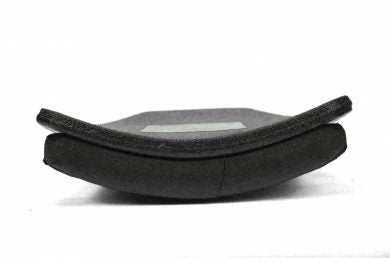It’s currently in fashion to disregard steel armor. To be sure, there are some significant differences between steel and ceramic composite armor, but there are a few things that steel can indeed do better than ceramic composite. It tends to be thinner and it produces virtually unmeasurable back face deformation. That means you are a lot more likely to stay in the fight. Steel is more durable than ceramic, but not nearly by the degree that many folks think. It is true that steel armor can be defeated by some threats that ceramic armor in the same rating might stop. But it will stop many threats that will cut through pistol rated armor like it isn’t there.
And that’s where steel really fits in. Not as a direct comparison to a level IV ceramic rifle plate or a level IIIA aramid vest, but as something in between. It gives you a relatively low cost, thin, and durable armor. CATI’s Combat Quad-Bend (CQB) plate has a complex curve that distributes weight better and also provides the capability of discrete wear. If fits in the middle as concealable armor plate that provides more protection than pistol armor but conceals better than ceramic composite rifle armor.

CQB BUILDUP COMPARED TO COMPOSITE PLATE
For $300 you get front and back, level III+ frag coated plates and a low profile concealable carrier. These III+ plates can be perforated by more unusual threats such as M855A1 and .30 M2AP, but they will stop M193 and almost any other .223 Rem or 5.56mm ammo as well as 7.62x51mm. While there are threats that will get through, they are not common and the fragmentation coating absorbs fragments from multiple shots. If you want to shave even more off the cost, downgrading from level III+ to level III and skipping the coating will save you $100.

CQB VS ADVANCED SINGLE CURVE VS FLAT PLATE
The obvious question is how concealable and how comfortable these plates are, though. There is no question that a thinner, more curved plate is more comfortable and more concealable, but what does that actually look like? Matt at Buffman R.A.N.G.E. put together a video which shows pretty clearly how realistic it is to conceal the CATI CQB.
As you can see, it isn’t completely invisible. Bear in mind that soft armor isn’t totally invisible, either. I’m sure you’ve all seen soft armor under a police officer’s uniform shirt. But this does demonstrate that the CQB can be worn somewhat discretely. Definitely less visible than a thicker plate, a flatter plate, or a MOLLE plate carrier.
I wore one around for a while and did some chores wearing it. The difference between the CQB plate and a flat plate was profound. It was also more comfortable than my single curve level IV plates. It’s not as comfortable as my level IIIA Second Chance vest, though.
Again, there are some not insignificant shortcomings for steel armor so don’t take this as a categorical endorsement for the CATI CQB armor. If you need something lighter, this isn’t for you. If you need a higher threat level, it isn’t for you either. But if you need something durable, affordable, comfortable, and concealable and if you need it to stop most rifle threats, the CQB might be a good choice.
 Your Privacy Choices
Your Privacy Choices
